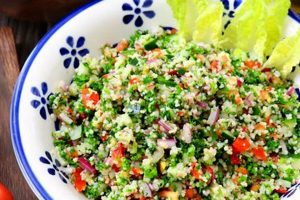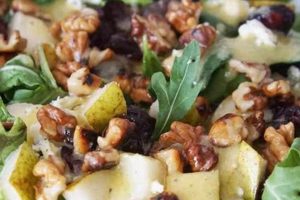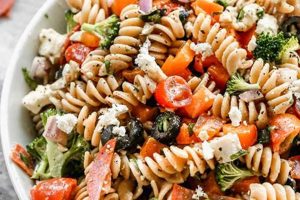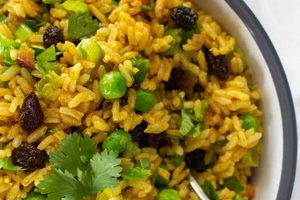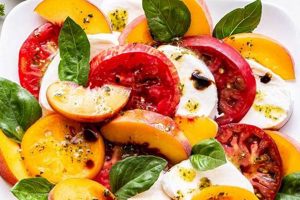A stale bread salad, also known as panzanella in Italian cuisine, transforms leftover bread into a flavorful and satisfying dish. Cubes of dried-out bread are rehydrated by soaking them in a vibrant mixture of vegetables, herbs, and a vinaigrette dressing. Classic variations often include tomatoes, cucumbers, onions, and basil, although the ingredients can be adapted based on seasonal availability and personal preference. The bread absorbs the flavorful juices, creating a unique textural experience.
This resourceful dish minimizes food waste by utilizing bread that might otherwise be discarded. It offers a versatile base for culinary creativity, allowing for a wide range of flavor profiles by incorporating different vegetables, cheeses, proteins, and dressings. Originating in peasant cultures, bread salads highlight the ingenuity of transforming humble ingredients into a nourishing and delicious meal. Their enduring popularity speaks to their adaptability and delicious simplicity.
The following sections will explore the essential techniques for crafting a perfect bread salad, offer inspiring variations, and delve deeper into the historical and cultural significance of this culinary tradition.
Tips for Creating Exceptional Bread Salads
Achieving a well-balanced and flavorful bread salad requires attention to detail and an understanding of the interplay between ingredients. The following tips offer guidance for crafting a dish that maximizes both texture and taste.
Tip 1: Bread Selection and Preparation: Stale, crusty bread is essential. Day-old loaves work best. Avoid overly soft breads, which tend to become mushy. Cube the bread into bite-sized pieces and dry it further in a low oven or on a countertop to achieve the ideal texture.
Tip 2: Vegetable Choices: Ripe, seasonal vegetables contribute the most vibrant flavors. Consider the balance of textures, incorporating both soft and crunchy elements. Tomatoes, cucumbers, onions, and bell peppers provide a classic foundation.
Tip 3: Dressing Emulsification: A well-emulsified vinaigrette is crucial for binding the salad and distributing flavor. Whisk the oil and vinegar vigorously until combined, or use a blender for a smoother emulsion. A touch of Dijon mustard can help stabilize the dressing.
Tip 4: Balancing Flavors: The interplay of sweet, sour, salty, and savory elements creates complexity. Balance the acidity of the vinaigrette with the sweetness of ripe tomatoes or the addition of a touch of honey. Salty cheeses or cured meats add savory notes.
Tip 5: Herbs and Aromatics: Fresh herbs contribute significantly to the overall aroma and flavor profile. Basil, parsley, oregano, and mint are excellent choices. Consider adding finely chopped garlic or shallots for a pungent dimension.
Tip 6: Resting and Marinating: Allowing the salad to rest for at least 30 minutes, or even longer, allows the bread to absorb the dressing and the flavors to meld. However, avoid over-marinating, as the bread can become overly saturated.
Tip 7: Serving and Presentation: Serve the salad at room temperature for optimal flavor. Garnish with extra herbs or a drizzle of olive oil for an appealing presentation. Consider adding a protein element like grilled chicken or chickpeas for a heartier meal.
By following these guidelines, one can consistently create a bread salad that showcases the versatility and deliciousness of this simple yet satisfying dish.
The following section will offer some concluding remarks on the enduring appeal of bread salads and their place in culinary traditions.
1. Stale Bread
Stale bread forms the cornerstone of bread salad, offering a unique textural and flavor-absorbing capacity not found in fresh bread. The loss of moisture concentrates the bread’s flavor and creates a firm structure capable of soaking up the vinaigrette without disintegrating into mush. This characteristic transforms what might be considered a less desirable ingredient into an essential component of a delicious and resourceful dish. Consider the Italian panzanella, where the use of stale bread is not merely acceptable but preferred for its ability to absorb the tomato juices and vinaigrette, resulting in a complex and satisfying medley of flavors and textures. Similarly, in Middle Eastern fattoush, the toasted or dried pita bread provides a satisfying crunch and absorbs the lemon-herb dressing, creating a harmonious balance of flavors.
The importance of stale bread extends beyond mere absorption. It offers a contrasting textural element to the fresh vegetables typically found in bread salads. This interplay of textures the slight chewiness of the rehydrated bread against the crispness of vegetables enhances the overall sensory experience. Furthermore, the drying process intensifies the bread’s inherent flavor, adding a subtle sweetness and nuttiness that complements the other ingredients. In regional variations, the choice of stale bread reflects local traditions. For example, Tuscan panzanella often utilizes day-old unsalted Tuscan bread, while fattoush commonly features pita bread.
Understanding the role of stale bread in bread salad is fundamental to appreciating the ingenuity and resourcefulness behind this culinary creation. It demonstrates the ability to transform a seemingly undesirable ingredient into a culinary asset. Successfully utilizing stale bread not only minimizes food waste but also unlocks unique flavors and textures central to the appeal of bread salad. This knowledge empowers culinary exploration, encouraging creativity in utilizing stale bread varieties and developing new variations on this classic dish.
2. Fresh Vegetables
Fresh vegetables play a crucial role in bread salad, providing vibrant flavors, contrasting textures, and essential nutrients. Their inclusion elevates the dish beyond repurposed stale bread, transforming it into a balanced and refreshing meal. The selection and preparation of these vegetables significantly influence the overall taste and textural complexity. Ripe, seasonal produce offers the most intense flavors and optimal textures. Consider the classic panzanella, where juicy ripe tomatoes provide a burst of sweetness and acidity that balances the savory notes of the bread and vinaigrette. The crisp cucumber adds a refreshing coolness and contrasting crunch. Similarly, the sharpness of red onion contributes a pungent bite that cuts through the richness of the other components.
Beyond the classic combination of tomatoes, cucumbers, and onions, a wide array of fresh vegetables can enhance bread salad. Bell peppers introduce sweetness and a satisfying crunch, while leafy greens like spinach or arugula offer a peppery bite and a boost of nutrients. Roasted vegetables, such as zucchini or eggplant, add a smoky depth of flavor and a tender texture. The choice of vegetables can be adapted to reflect seasonal availability and regional preferences. A summer bread salad might feature fresh corn kernels and ripe peaches, while a fall version could incorporate roasted butternut squash and crisp apples. This adaptability allows for endless variations, ensuring a constantly evolving culinary experience.
The careful selection, preparation, and incorporation of fresh vegetables are essential for a successful bread salad. They contribute not only to the nutritional value but also to the overall balance of flavors, textures, and colors. Understanding the interplay between these elements allows for a deeper appreciation of the culinary artistry involved in creating this seemingly simple yet complex dish. The judicious use of fresh, seasonal ingredients elevates bread salad from a humble dish of repurposed stale bread to a vibrant and satisfying culinary creation.
3. Vinaigrette
Vinaigrette serves as the unifying element in a bread salad, binding the disparate ingredients and imbuing the dish with a cohesive flavor profile. Its importance extends beyond mere dressing; it acts as a marinade, softening the stale bread and allowing it to absorb the flavors of the other components. The careful balance of acidity, oil, and seasonings within the vinaigrette is crucial to the overall success of the dish.
- Acidity:
The acidic component, typically vinegar or citrus juice, provides brightness and cuts through the richness of the bread and other ingredients. The type of acid used significantly influences the final flavor profile. A red wine vinaigrette lends a robust, fruity note, while a lemon vinaigrette offers a lighter, more citrusy accent. The acidity also plays a crucial role in balancing the overall flavor composition, preventing the salad from becoming overly bland or heavy.
- Oil:
Oil provides richness and body to the vinaigrette, coating the ingredients and contributing to a satisfying mouthfeel. Extra virgin olive oil is a common choice, offering a fruity, peppery flavor that complements many vegetables. Other oils, such as avocado or walnut oil, can be used to create unique flavor profiles. The ratio of oil to acid affects the texture and intensity of the vinaigrette.
- Seasonings:
Seasonings enhance the complexity of the vinaigrette, adding depth and nuance to the overall flavor. Salt and pepper are fundamental, but other seasonings, such as Dijon mustard, garlic, herbs, or spices, can be incorporated to create a wide range of flavor combinations. The choice of seasonings should complement the other ingredients in the salad and contribute to a harmonious balance of flavors. For instance, a Mediterranean-inspired bread salad might benefit from the addition of oregano and crumbled feta cheese to the vinaigrette.
- Emulsification:
Emulsification, the process of combining oil and acid into a stable mixture, is essential for a successful vinaigrette. A well-emulsified vinaigrette clings evenly to the ingredients, ensuring consistent flavor distribution. Wh whisking or blending the ingredients thoroughly creates a smooth, creamy texture that enhances the overall sensory experience of the bread salad. A stable emulsion prevents the vinaigrette from separating, ensuring a visually appealing and evenly flavored dish.
The vinaigrette in a bread salad is more than just a dressing; it is the conductor of flavor, orchestrating the diverse ingredients into a harmonious whole. Its careful construction, considering the balance of acidity, oil, seasonings, and emulsification, is essential for creating a bread salad that is not only flavorful but also texturally satisfying. The interplay of these elements elevates the dish from a simple combination of ingredients to a complex and rewarding culinary experience.
4. Herbs
Herbs provide an essential aromatic dimension to bread salads, elevating them from simple combinations of bread and vegetables to complex and flavorful dishes. Their inclusion contributes not only to the overall taste but also to the aroma and visual appeal. The selection and application of herbs significantly influence the final character of the salad, offering opportunities for culinary creativity and regional variations.
- Flavor Enhancement:
Herbs contribute a wide range of flavors, from the bright, peppery notes of basil to the earthy undertones of oregano. These flavors interact with the other ingredients, creating a more complex and nuanced taste profile. For example, mint adds a refreshing coolness that complements cucumber and feta, while parsley provides a clean, herbaceous flavor that balances the richness of roasted vegetables. The careful selection of herbs allows for customization, tailoring the flavor profile to specific preferences and regional culinary traditions.
- Aromatic Complexity:
The aromatic oils present in herbs contribute significantly to the sensory experience of consuming a bread salad. The volatile compounds released upon chopping or tearing the herbs create an enticing fragrance that enhances the overall enjoyment. Basil, with its sweet, anise-like aroma, complements tomato-based salads, while the pungent aroma of rosemary pairs well with roasted vegetables and richer dressings. This aromatic complexity adds another layer of sensory depth to the dish, elevating it beyond a simple combination of ingredients.
- Visual Appeal:
The vibrant green hues of fresh herbs contribute to the visual appeal of a bread salad, adding a pop of color that contrasts with the other ingredients. The varying textures and shapes of different herbs, from the delicate leaves of parsley to the broader leaves of basil, create visual interest. A sprinkle of chopped chives or a garnish of whole mint leaves can elevate the presentation, transforming a simple bread salad into a visually appealing culinary creation. This visual element adds to the overall dining experience.
- Cultural and Regional Variations:
The use of specific herbs in bread salads often reflects regional culinary traditions. In Italian panzanella, basil is a common choice, complementing the ripe tomatoes and olive oil. In Middle Eastern fattoush, parsley and mint are frequently used, adding a refreshing herbal note to the lemon-herb dressing. These regional variations demonstrate the adaptability of bread salad and the role of herbs in shaping distinct culinary identities. Exploring these variations offers insights into diverse culinary heritages and provides inspiration for creative adaptations.
The thoughtful incorporation of herbs into a bread salad elevates the dish beyond its basic components, creating a symphony of flavors, aromas, and textures. Understanding the role of herbs in flavor enhancement, aromatic complexity, and visual appeal allows for a more nuanced approach to creating and appreciating this versatile dish. From the classic pairings of basil with tomatoes to the refreshing coolness of mint, herbs contribute significantly to the overall sensory experience and cultural significance of bread salad.
5. Optional Protein
The addition of protein to bread salad transforms it from a side dish or light meal into a more substantial and complete main course. While not strictly essential to the core concept of bread salad, protein significantly contributes to its nutritional value and satiety, broadening its appeal and versatility. The choice of protein influences the overall flavor profile and can be tailored to complement the other ingredients and desired culinary style.
Several protein options seamlessly integrate into bread salad. Grilled chicken or fish offer lean protein sources that pair well with Mediterranean-inspired flavors. Chickpeas or cannellini beans provide plant-based protein and contribute a creamy texture, aligning with vegetarian or vegan preferences. Salami, prosciutto, or other cured meats introduce salty, savory notes that complement robust vegetable combinations. Cheese, such as feta, mozzarella, or goat cheese, adds protein while also contributing to the overall flavor and texture. The quantity of protein added depends on the desired heartiness of the salad and the other ingredients present. For example, a larger portion of grilled chicken might be appropriate for a main course salad, while a smaller amount of crumbled feta might suffice for a lighter option.
Understanding the impact of optional protein on bread salad allows for greater flexibility and customization. The choice of protein can be strategically employed to enhance nutritional value, create a more satisfying meal, and complement the chosen flavors and textures. This awareness empowers culinary creativity and enables the adaptation of bread salad to diverse dietary needs and preferences. Whether seeking a light lunch, a hearty dinner, or a protein-packed post-workout meal, the strategic inclusion of protein elevates bread salad from a simple accompaniment to a versatile and satisfying culinary centerpiece.
6. Flavor Balance
Flavor balance is paramount in a successful bread salad, ensuring a harmonious interplay of tastes that elevates the dish beyond a mere assembly of ingredients. Achieving this balance involves a careful consideration of contrasting yet complementary flavor profiles, creating a complex and satisfying sensory experience. A well-balanced bread salad avoids extremes, ensuring no single flavor dominates and allowing the nuanced characteristics of each component to shine through.
- Acidity:
Acidity, often derived from vinegar or citrus juice in the vinaigrette, provides brightness and cuts through the richness of the bread and other ingredients. It balances the inherent sweetness of ripe tomatoes or other sweet vegetables and prevents the salad from becoming overly heavy. The level of acidity should be carefully calibrated to complement the other flavors without overpowering them. For instance, a balsamic vinaigrette provides a deeper, sweeter acidity compared to a light lemon vinaigrette, influencing the overall flavor profile.
- Saltiness:
Salt enhances the flavors of the other ingredients and provides a crucial counterpoint to the acidity. It can be introduced through salty cheeses like feta or Parmesan, cured meats like prosciutto or salami, or simply through seasoned croutons or the vinaigrette itself. The level of saltiness must be carefully balanced to avoid overpowering the other flavors. The type of salt used can also influence the final taste; for example, flaky sea salt offers a different textural and flavor experience compared to finely ground table salt.
- Sweetness:
Sweetness, often derived from ripe tomatoes, roasted vegetables, or a touch of honey or sugar in the vinaigrette, adds depth and complexity to the salad. It balances the acidity and saltiness, preventing the dish from becoming too tart or savory. The sweetness should be subtle and integrated, allowing the other flavors to shine. Incorporating naturally sweet vegetables like roasted red peppers or caramelized onions adds depth and complexity beyond simply adding sugar.
- Savory/Umami:
Savory or umami notes add a depth of flavor and contribute to a more satisfying and complex taste experience. These can be introduced through ingredients like olives, capers, anchovies, or aged cheeses. Umami-rich ingredients enhance the overall flavor profile without overpowering the other elements. Incorporating ingredients like sun-dried tomatoes or mushrooms can add a savory depth that balances the brighter flavors of fresh vegetables and herbs.
The interplay of these four flavor components acidity, saltiness, sweetness, and savory/umami creates a well-balanced and harmonious bread salad. A successful recipe carefully considers the contributions of each element, ensuring no single flavor dominates but rather that they work together to create a complex and satisfying culinary experience. The balance achieved elevates the dish from a simple combination of ingredients to a sophisticated and flavorful creation.
7. Resting Time
Resting time is a crucial element in preparing bread salad, significantly impacting the final texture and flavor. This period allows the stale bread to absorb the vinaigrette and the flavors of the other ingredients to meld, creating a more cohesive and flavorful dish. The duration of resting time influences the degree of bread saturation and the intensity of flavor development.
- Flavor Infusion:
Resting allows the vinaigrette to permeate the bread, softening its texture and infusing it with the flavors of the acidic component, oil, and any included herbs or spices. This process transforms the stale bread from a dry, potentially bland base into a flavorful and integral part of the salad. The flavors of the vegetables also mingle with the bread, creating a more unified and complex flavor profile.
- Texture Development:
As the bread absorbs the vinaigrette, its texture evolves from hard and crusty to a more yielding and palatable consistency. The resting period allows for controlled hydration, preventing the bread from becoming overly soggy while ensuring it achieves the desired softness. This transformation is key to the distinctive textural experience of bread salad, offering a pleasant contrast to the crispness of fresh vegetables.
- Flavor Melding:
Resting time facilitates the melding of flavors from various components. The individual flavors of the vegetables, herbs, and vinaigrette combine and harmonize, creating a more complex and nuanced overall taste. This integration of flavors results in a more balanced and satisfying culinary experience, where the individual components contribute to a greater whole. For instance, the sweetness of tomatoes might meld with the sharpness of red onion and the herbaceous notes of basil, creating a more intricate and balanced flavor profile.
- Optimal Duration:
The optimal resting time depends on the type of bread used, the desired texture, and the specific recipe. Generally, a minimum of 30 minutes is recommended to allow for adequate flavor infusion and softening of the bread. However, some recipes might benefit from a longer resting period, up to a few hours, to allow for deeper flavor development and more thorough bread saturation. Overly long resting periods, however, can result in excessively soggy bread, so careful monitoring is crucial.
Resting time is integral to the successful preparation of bread salad, influencing both texture and flavor development. It allows the stale bread to absorb the vinaigrette and the flavors of the other ingredients to meld, resulting in a more cohesive and satisfying final product. Understanding the importance of this step and its impact on the final dish allows for greater control over the outcome and ensures a more enjoyable culinary experience.
Frequently Asked Questions
This section addresses common inquiries regarding bread salad preparation, offering practical guidance for achieving optimal results.
Question 1: What type of bread is best suited for bread salad?
Crusty, day-old bread works best. Avoid overly soft breads, which tend to become mushy. Examples include ciabatta, sourdough, and country loaves.
Question 2: Can fresh bread be used?
While not ideal, fresh bread can be used if dried adequately. Cube the bread and toast it in a low oven or leave it on a countertop overnight to remove excess moisture.
Question 3: How long should the salad rest before serving?
A minimum of 30 minutes allows the bread to absorb the dressing and flavors to meld. Longer resting times, up to a few hours, can enhance flavor development, but avoid over-marinating, which can lead to soggy bread.
Question 4: What vegetables can be included in a bread salad?
A wide variety of vegetables complement bread salad, including tomatoes, cucumbers, onions, bell peppers, and leafy greens. Seasonal vegetables offer optimal flavor and texture. Roasted vegetables can also add depth and complexity.
Question 5: Can bread salad be made ahead of time?
Yes, bread salad can be prepared a few hours in advance. However, add delicate herbs or leafy greens just before serving to prevent wilting. Store the salad without these additions in the refrigerator until ready to serve.
Question 6: How can one prevent the bread from becoming overly soggy?
Using stale bread and monitoring the resting time are crucial. Add the dressing gradually, ensuring the bread absorbs the liquid without becoming saturated. Avoid over-marinating the salad.
Careful consideration of these frequently asked questions ensures successful bread salad preparation, resulting in a flavorful and texturally satisfying dish.
The following section will offer some concluding remarks on preparing bread salad.
Recipe Bread Salad
Crafting a well-executed bread salad hinges on a thorough understanding of its core components: stale bread as a flavor-absorbing foundation, the vibrancy of fresh vegetables, the unifying role of a balanced vinaigrette, the aromatic lift of herbs, the potential for protein enrichment, the importance of flavor balance, and the transformative influence of resting time. Each element contributes to the dish’s overall character, showcasing the potential of simple ingredients to create a complex and satisfying culinary experience.
Bread salad represents more than a mere recipe; it embodies resourcefulness, culinary creativity, and an appreciation for the interplay of flavors and textures. Exploration of diverse regional variations and ingredient combinations offers a pathway to culinary discovery, encouraging ongoing experimentation and a deeper understanding of this versatile dish’s enduring appeal.

